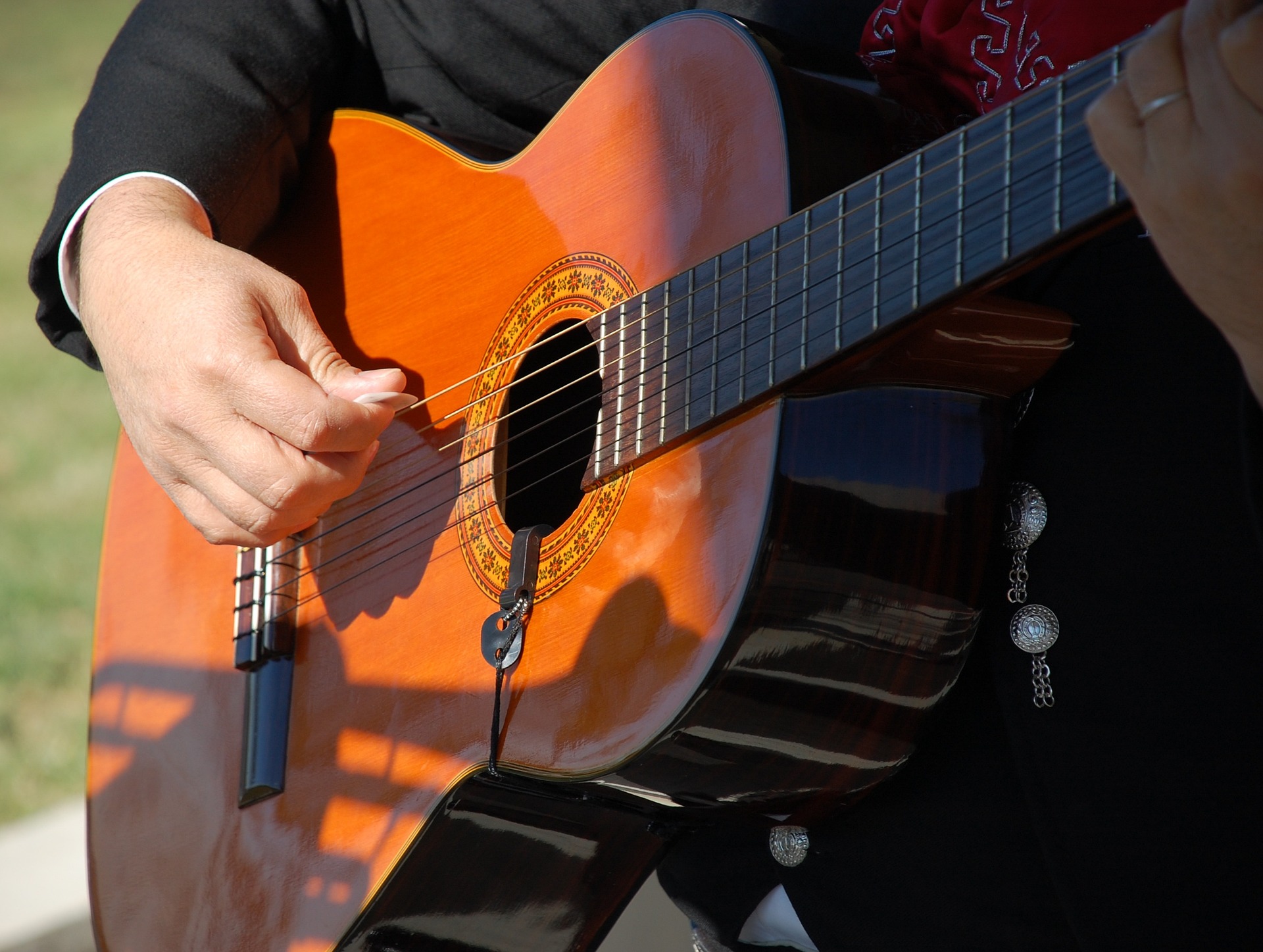Music is a fundamental element of Mexican culture, and it is featured in nearly every celebration or gathering. Much of Mexico’s music emphasizes themes of love and passion as well as the history and oppression experienced within the country, often affirming the familial and gender roles valued there. Traditional Mexican music has emerged from multiple different regions at varying times throughout the history of the country. With influence of indigenous instruments and rhythms, six main genres have developed as part of Mexico’s musical culture. These include Banda, Huapango, Mariachi, Rancheras, Son Huasteco and Son Jarocho.
Banda or Norteña is a genre composed in a quick tempo featuring a heavy horn section. It sounds similar to polka with a two-note beat, this musical influence is due in part to an influx of German settlers in Texas in 1830, which was still part of Mexico at the time. Songs like Mi Ranchito by El Coyote Y Su Banda Tierra Santa and Adios Amor by Christian Nodal are recognizable songs from this genre.
Huapango is a genre that utilizes Spanish instruments and a Mexican rhythm. The beat is much faster and more complex than other similar genres. It features songs like La Guitarra de Lolo (Huapango) and Ordeñando La Vaca.
Mariachi, one of the more well-known Mexican genres, is considered an ongoing cultural revolution in the country. It began in southern Mexico in the early 19th century, but has since spread far and wide. Today, Mariachi referes to the band of instruments required to create the music and the notable costumes donned by its performers. Volver Volver and México Lindo Y Querido by Vincente Fernández are two of the genre’s most notable songs.
Rancheras is another highly popular Mexican genre, and is characterized by Mariachi arrangements. This means that the genres are deeply intertwined. Created by Mexican cowboys, Rancheras was popularized in the 20th century by Golden Age Mexican films, like “¡Vamonos con Pancho Villa!” from 1936 and “Enamorada” from 1946. Some significant rancheras songs include Por Mujeres Como Tú by Pepe Aguilar, Si Nos Dejan by Luis Miguel and El Rey by Vincente Fernández.
Son Huasteco and Son Jarocho are Mexico’s folk genres with more unique sounds. Son Huasteco uses instruments exclusive to the Northeastern region, like a “guitarra quinta,” (eight-stringed guitar) and a five-stringed guitar called the “jarana huasteca.” These instruments can be heard in songs like La Leva by Los Caimanes and El Querreque by Los Grandes Huapangos. Son Jarocho, which originated from the Veracruz region along the Gulf of Mexico, is a blend of Spanish and Afro-Caribbean influence. Its music typically features a harp, a “jarana” and a “requinto,” or four-stringed guitar. La Bamba by Tlen Huicani and Lino Chavez was originally a Jarocho song, but was reinterpreted and popularized as a rock ‘n’ roll hit by Ritchie Valens in the 1950s.
As deeply as Mexican music is ingrained within the culture of the country and its regions, it is also evolving and modernizing. Natalie Lafourcade and Julieta Venegas are two artists who are attempting to revive the sentiment of national and cultural pride in Mexico, as headlines highlighting the country’s violence and turmoil are on the rise.
Julieta Venegas is an American-born Mexican singer who grew up in Tijuana and has played a multitude of genres throughout her career. She recently released her seventh album, “Los Momentos,” which is a callback to the music of the early 1980s in Mexico, before economic and political unrest struck the country. She was a teenager in the 1980s, and the influences of European disco can be clearly heard throughout the album. The sounds of this album are synthesized and subtle, but her lyrics describe a time when Mexico was peaceful. She calls for harmony and unity among Mexicans as they are the only ones who can heal the country of its fear and disorder.
Natalie Lafourcade is a folk artist raised by classical musicians in the Veracruz region of Mexico. She began her career in rock ‘n’ roll as a teenager and left home for Canada shortly thereafter. After writing and performing in Canada, she found herself lost and confused about the direction of her career, and eventually started to write alternative music. She has since moved on to celebrating and reviving the music of Veracruz, Son Jarocho.
In 2020, she released the first album of a two-part project, titled Un Canto por México, Vol. 1, in an effort to fund-raise for the reconstruction of Veracruz. This was after Mexico was hit with a powerful earthquake in 2017 that devastated the region. This region is not only where Lafourcade was raised, but it is also a cultural and musical center for Mexico. With this album, she modernized some of the country’s most well-known songs, such as Cucurrucucú Paloma. She won several Grammys for the album, including a 2021 Grammy for best regional Mexican music album and a Latin Grammy for best album of the year.
Delayed by the pandemic, Lafourcade released the second album of the series: Un Canto por México, Vol. 2 the following year. It features folk revisions of both traditional Mexican songs and Lafourcade’s own previously recorded songs. On this project, she converted the music of other famous Mexican artists into genres that she had never experimented with before. She used folkloric sounds and Mariachi arrangements along with new voices and instruments to encapsulate the history and tradition of Mexican music with a new, modern sound. She pays respect to the original music while creating something new, extravagant, and complex. The music pays homage to the art, history and culture of both her own personal experiences and traditional Mexican music as a whole.
Both artists utilize sounds of traditional Mexican music from different time periods: Venegas utilizes influences from the 1980s and Lafourcade from the late 19th and early 20th centuries. Although the instruments and compositions of their music are completely different, the message is the same. Lafourcade and Venegas are reviving traditional Mexican music to inspire and encourage Mexicans to unite for the reconciliation of the country and the revitalization of its culture.

















